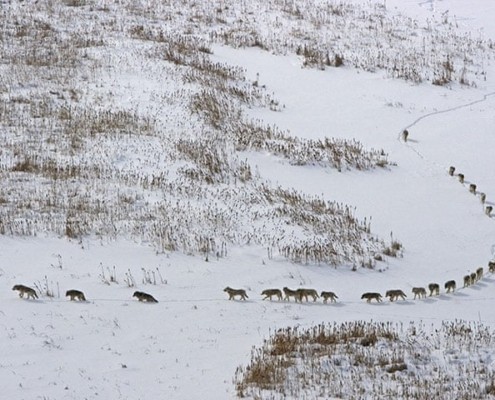The internet is rife with fascinating images, often accompanied by captions that, while captivating, may not always hold water. One such image, a striking photograph of a wolf pack trekking through the snow, has been circulating for years with an elaborate description of pack dynamics. This article delves into the reality of How Wolf Packs Travel, separating fact from fiction and shedding light on the true social structures and strategies employed by these magnificent creatures.
That viral photo, captured by Chadden Hunter for a BBC series in 2011, depicts a pack of wolves in Wood Buffalo National Park. The popular caption suggests the lead wolves are old or sick, setting the pace for the pack, followed by the strongest, with the alpha bringing up the rear to oversee everything. However, this interpretation is inaccurate and perpetuates misconceptions about wolf behavior.
 Wolf pack traveling in single file through deep snow.
Wolf pack traveling in single file through deep snow.
The reality of how wolf packs travel is far more practical and energy-efficient. Wolves, like any animal navigating deep snow, travel in a single line to conserve energy. The wolf at the front essentially breaks the trail, making it easier for those following behind. It’s a system designed for efficiency, not a display of sacrifice from the old or weak. Logic dictates that placing the most vulnerable wolves in the lead would be detrimental to the pack’s survival, as breaking trail requires significant energy expenditure.
Imagine yourself trudging through deep snow; it’s exhausting. Now, consider doing so if you were elderly, injured, or unwell. The same principle applies to wolves.
The wolf at the back of the pack isn’t necessarily an “alpha” strategically overseeing the group. This wolf may simply have fallen behind for various reasons. It could be investigating a scent, struggling to keep up due to injury or fatigue, or simply taking a moment to rest. The position at the rear doesn’t automatically denote leadership or control.
 Wolf pack traveling in single file through deep snow.
Wolf pack traveling in single file through deep snow.
The concept of a rigid “alpha” structure within wolf packs has also been largely debunked. While dominance hierarchies exist, the term “alpha” can be misleading and oversimplifies the complex social interactions within a pack. Modern research suggests that wolf packs primarily function as family units, with the breeding pair naturally taking on leadership roles. These roles are earned through experience and parental responsibility, not necessarily through aggressive displays of dominance.
Therefore, understanding how wolf packs travel requires moving beyond romanticized notions and embracing a more nuanced understanding of their behavior. Wolves are intelligent, social animals that have developed efficient strategies for survival in challenging environments. Traveling in a single line to conserve energy is a testament to their adaptability and cooperative nature.
By dispelling myths surrounding wolf pack dynamics, we can foster a greater appreciation for these remarkable creatures and their intricate social lives. The next time you see that captivating image of a wolf pack in the snow, remember the science behind their movements and the true meaning of teamwork in the wild.
